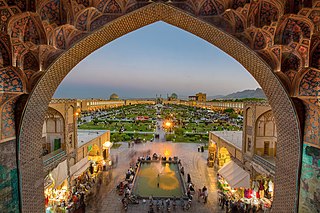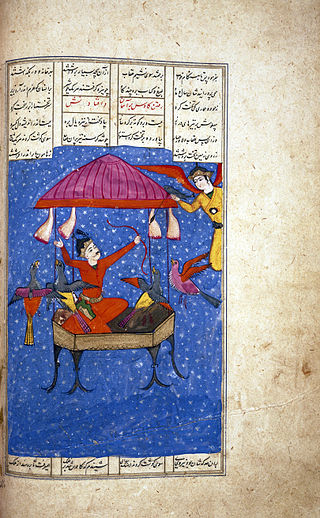
Abul-Qâsem Ferdowsi Tusi, also Firdawsi or Ferdowsi, was a Persian poet and the author of Shahnameh, which is one of the world's longest epic poems created by a single poet, and the greatest epic of Persian-speaking countries. Ferdowsi is celebrated as one of the most influential figures of Persian literature and one of the greatest in the history of literature.

The Shahnameh or Shahnama is a long epic poem written by the Persian poet Ferdowsi between c. 977 and 1010 CE and is the national epic of Greater Iran. Consisting of some 50,000 "distichs" or couplets, the Shahnameh is one of the world's longest epic poems. It tells mainly the mythical and to some extent the historical past of the Persian Empire from the creation of the world until the Muslim conquest in the seventh century. Iran, Azerbaijan, Afghanistan, Tajikistan and the greater region influenced by Persian culture such as Armenia, Dagestan, Georgia, Turkey, Turkmenistan and Uzbekistan celebrate this national epic.

Isfahan, from its ancient designation Aspadana and, later, Spahan in middle Persian, rendered in English as Ispahan, is a major city in the Central District of the Isfahan Province of Iran. It is located 440 kilometres south of Tehran and is the capital of Isfahan Province. The city has a population of approximately 2,220,000, making it the second -largest city in Iran, after Tehran and the second-largest metropolitan area.

Isfahan Province, also transliterated as Esfahan, Espahan, Isfahan, or Isphahan, is one of the 31 provinces of Iran. The capital of the province is the city of Isfahan. It is located in the center of the country in Iran's Region 2, whose secretariat is located in Isfahan.

Abu Nasr Ali ibn Ahmad Asadi Tusi was a Persian poet, linguist and author. He was born at the beginning of the 11th century in Tus, Iran, in the province of Khorasan, and died in the late 1080s in Tabriz. Asadi Tusi is considered an important Persian poet of the Iranian national epics. His best-known work is Garshaspnameh, written in the style of the Shahnameh.

Mohammad-Taqi Bahar, widely known as Malek osh-Sho'arā and Malek osh-Sho'arā Bahār, was a renowned Iranian poet, scholar, politician, journalist, historian and Professor of Literature. Although he was a 20th-century poet, his poems are fairly traditional and strongly nationalistic in character. Bahar was father of prominent Iranist, linguist, mythologist and Persian historian Mehrdad Bahar.

Rostam or Rustam is a legendary hero in Persian mythology, the son of Zāl and Rudaba, whose life and work was immortalized by the 10th-century Persian poet Ferdowsi in the Shahnameh, or Epic of Kings, which contains pre-Islamic Iranian folklore and history. However, the roots of the narrative date much earlier.

Kay Kāvus ; sometimes Kai-Káús or Kai-Kaus, is a mythological shah of Greater Iran and a character in the Shāhnāmeh. He is the son of Kay Qobād and the father of prince Seyāvash. Kāvus rules Iran for one hundred and fifty years during which he is frequently though increasingly grudgingly aided by the famous hero Rostam. He is succeeded by his grandson Kay Khosrow.

Ahmad Ebādi was an Iranian musician and setar player. Born in Tehran, he was a member of the most extraordinary family of Iranian music. Ahmad's father, Mirza Abdollah, is arguably the most influential figure in Persian traditional music, and his paternal uncle, Mirza Hossein Gholi, is also well known for his mastery in playing the tar. Ahmad's paternal grandfather, Ali Akbar Farahani, was also a talented musician.
Persian theater goes back to antiquity. The first initiation of theater and phenomena of acting can be traced in ceremonial theaters to glorify national heroes and legends and to humiliate the enemy, as in the classics "Soug Sivash" and "Mogh Koshi" (Megakhouni). Ancient Persian theatre and dance was significantly researched by the Greek historian Herodotus of Halikarnassos, who lived during the Persian rule in Greece. In his work Book IX (Calliope), he describes the history of Asian empires and also the Persian wars until 478 BC.
Shahin Shahr is a city and capital of Shahin Shahr and Meymeh County, Isfahan Province, Iran. At the 2016 census, its population was 173,329 in 35,827 families.

Mehdi Forough (1911–2008) was an Iranian scholar, author, dramatist, writer on dramatic arts and culture, translator, and founder of the Academy of Dramatic Arts in Tehran. A native of Esfahan, Mehdi Forough attended Danesh Sara-ye Aali in Tehran and went on to study at the Royal Academy of Dramatic Arts, London. He did graduate studies at Columbia University, NYC, where he completed his thesis, Comparative study of Abraham's sacrifice in Persian passion plays and Western mystery plays, 1954. This work was later published by the Ministry of Culture, in Tehran.

The Pishdadian dynasty is a mythical line of primordial kings featured in Zoroastrian belief and Persian mythology, who are presented in legend as originally rulers of the world but whose realm was eventually limited to Ērānshahr or Greater Iran. Although there are scattered references to them in the Zoroastrian scriptures – the Avesta – and later Pahlavi literature, it is through the 11th century Iranian national epic, the Shahnameh, that the canonical form of their legends is known. From the 9th century, Muslim writers, notably Tabari, re-told many of the Pishdadian legends in prose histories and other works. The Pishdadian kings and the stories relating to them have no basis in historical fact, however.

Piranshahr is a city in the Central District of Piranshahr County, West Azerbaijan province, Iran, and serves as capital of the county.

The Tomb of Ferdowsi is a tomb complex composed of a white marble base, and a decorative edifice erected in honor of the Persian poet Ferdowsi located in Tus, Iran, in Razavi Khorasan province. It was built in the early 1930s, under the regime of Reza Shah, and uses mainly elements of Achaemenid architecture to demonstrate Iran's rich culture and history. The construction of the mausoleum as well as its aesthetic design is a reflection of the cultural, and geo-political status of Iran at the time.

Ayatollah Ata'ollah Ashrafi Esfahani was an Iranian religious leader. He was born near Esfahan and educated in Esfahan and at the Qom Seminary. He became a mojtahed when he was 40. After the Islamic Revolution of 1979, he was selected as the Imam Jumu'ah for the city of Kermanshah. He was killed by a member of the Mujahideen-e Khalq during Friday prayer on 15 October 1982.

Goudarz is one of the main Iranian heroes in Shahnameh, the national epic of Greater Iran, and progenitor of one of its most prominent families. He is son of Kashvad, father of Giv and Roham and the grandfather of Bizhan. His first appearance is in the time of Kay Kavus and thereafter he appears almost in every story of the heroic age, sometimes he is the spahbed of Iranian Army. His personality is described very positively with traits such as loyalty, patience and altruism.

Ashkbous is a Kashanian hero in Shahnameh who fights with Iranians in the Battle of Kamous-e Kashani. In Bondari's translation of Shahnameh into Arabic, his name is given as Askbos. In the story of Kamous, Ashkbous first fights with Rohham and defeats him, but he himself was defeated and killed by Rostam who was fighting on foot without Rakhsh. The battle of Rostam and Ashkbous was a popular choice in Persian miniature. It has been suggested that Kashanians or Koshanians are related to Kushan Empire.

Cecilia Banu was a scholar of Iranian studies, a poet and a translator from the Persian language to Russian. She is best known for her multi-volume translation of the Shahnameh of Ferdowsi.

Malek Jamshid is the twelfth studio album by Iranian singer-songwriter and guitarist Kourosh Yaghmaei. The album was released on June 10, 2016 by Now-Again Records in the United States after it was banned in Iran. The title refers to the legendary king Jamshid from the Shahnameh.

















